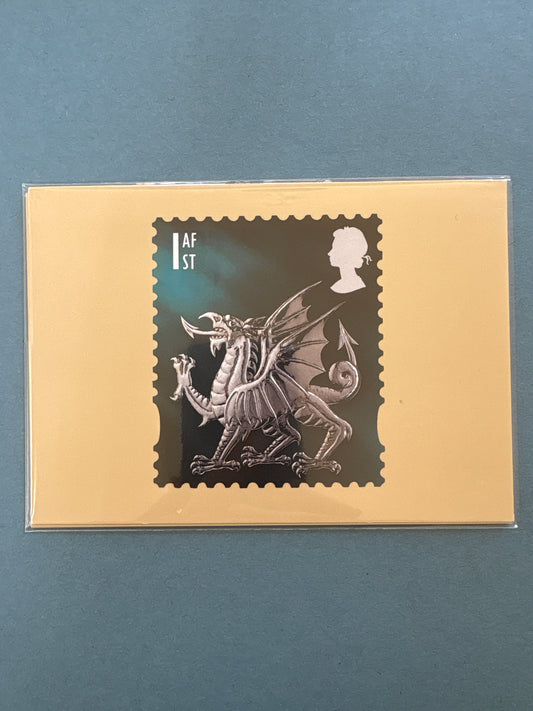Collection: Postal Headquarters Cards (PHQ)
PHQ cards—short for Postal Headquarters cards—are a distinctive and much-loved feature of British philately. These postcard-sized reproductions of Royal Mail’s commemorative stamp designs have become a collectible format in their own right, with a history that dates back to the early 1970s.
The first PHQ card was issued on 16 May 1973 to coincide with the County Cricket Centenary stamp set. It featured the 3p W.G. Grace stamp and was initially intended as a simple picture postcard available at post offices and philatelic counters. However, collectors quickly saw their potential. By affixing the matching stamp to the card and obtaining a First Day of Issue postmark, they created a new collectible hybrid: the used PHQ card. This practice gave rise to two distinct collecting styles—cards kept mint (without stamps) and those used with stamps and postmarks.
The popularity of PHQ cards grew rapidly. A second card followed in August 1973 for the Inigo Jones commemorative stamp, and by 1976, Royal Mail had adopted a more consistent issuing policy. From that point onward, a set of PHQ cards was produced for nearly every new commemorative stamp issue. Each card replicated the design of an individual stamp, printed in larger format on high-quality card stock. The reverse typically included the PHQ number, a brief description, and space for a message or address.
Collectors often distinguish between mint PHQ cards—kept in pristine, unused condition—and used cards, which have the corresponding stamp affixed and are cancelled with a First Day of Issue postmark. Some enthusiasts prefer to mount the stamp on the picture side of the card, aligning it with the printed design, while others place it on the reverse. Both approaches are valid, though the former is more visually striking and popular among display collectors.
Over the years, PHQ cards have reflected the full breadth of Royal Mail’s commemorative themes—from royal events and historical anniversaries to British flora, fauna, and cultural icons. Their appeal lies in their accessibility, affordability, and the way they bring stamp art to life on a larger canvas. For many, they serve as an entry point into philately, offering a tactile and visually engaging way to explore stamp collecting.
The format has remained largely consistent since the mid-1970s, though the earliest two cards were slightly larger in size. These early issues are now considered rarities, especially in mint condition, and can command higher prices among collectors. Despite their widespread availability, certain PHQ cards—particularly those with printing errors, limited distribution, or tied to significant events—have become sought-after items.
Today, PHQ cards continue to be issued alongside new stamp releases, maintaining their place as a staple of British philatelic culture. Whether collected mint, used, or as part of a thematic display, they offer a charming blend of art, history, and postal tradition—proof that even a humble postcard can carry a world of meaning. And for collectors, there’s a quiet satisfaction in pairing a stamp with its illustrated twin and capturing a moment in time with ink and paper.
-
PHQ FDC - Set of all 4 Cards in the British Motor Cars Set of 1982 PHQ63 as First Day Covers
Regular price £4.00 GBPRegular priceUnit price / per -
PHQ FDC - London 1980 International Stamp Exhibition PHQ Card with Matching Stamp on rear
Regular price £2.00 GBPRegular priceUnit price / per -
PHQ FDC - London 1980 International Stamp Exhibition PHQ Card with Matching Stamp on front
Regular price £2.00 GBPRegular priceUnit price / per -
PHQ - Mint Set of all 4 Cards in the Millennium Series - The Scientist's Tale 1999 PHQ210
Regular price £5.00 GBPRegular priceUnit price / per -
PHQ - Mint Set of all 4 Cards in the World Student Games and Rugby World Cup Set of 1991 PHQ135
Regular price £2.00 GBPRegular priceUnit price / per -
PHQ - Mint Set of all 4 Cards in the Royal Golden Wedding Set of 1997 PHQ192
Regular price £5.00 GBPRegular priceUnit price / per -
PHQ - Mint Set of all 4 Cards in the Welsh Regional Set of 1999 D13
Regular price £5.00 GBPRegular priceUnit price / per -
PHQ - Mint Set of all 4 Cards in the Millennium Projects (1st Series) 'Above and Beyond' PHQ215
Regular price £5.00 GBPRegular priceUnit price / per -
PHQ - Mint Set of all 5 Cards in the Millennium Timekeeper Set PSM02
Regular price £5.00 GBPRegular priceUnit price / per








